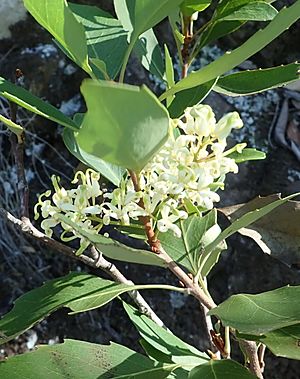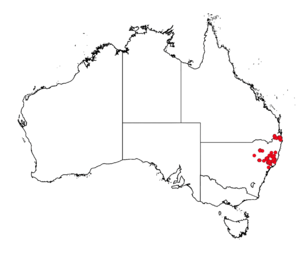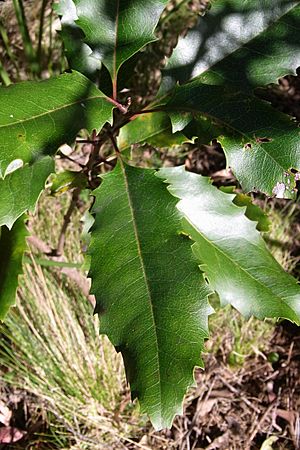Smooth lomatia facts for kids
Quick facts for kids Smooth lomatia |
|
|---|---|
 |
|
| Lomatia arborescens in Mount Kaputar National Park | |
| Scientific classification | |
| Genus: |
Lomatia
|
| Species: |
arborescens
|
 |
|
| Occurrence data from AVH with cultivated specimens removed | |
| Synonyms | |
The Lomatia arborescens, also known as smooth lomatia or tree lomatia, is a type of shrub or small tree. It grows in high places, often found near rainforests. You can find this plant in eastern Australia, starting from the Barrington Tops area and going north.
Contents
What Does It Look Like?
The smooth lomatia can grow into a large shrub or a small tree. It can reach up to 10 meters (about 35 feet) tall. Its bark is a greyish-brown color.
Leaves
The leaves of this plant are smooth. They are shaped like an oval or a spear (this is called lanceolate). They can be from 3 to 15 centimeters (1.2 to 6 inches) long. They are also 1.5 to 6 centimeters (0.6 to 2.2 inches) wide.
The size and edges of the leaves can change. In places that are protected, the leaves are usually bigger. They also have jagged edges, like a saw. In windy or open spots, the leaves are smaller and have smooth edges. If you look closely at the top of the leaves, you can see a network of veins.
Flowers
The smooth lomatia has white flowers. These flowers grow in clusters called racemes. They appear from the plant's side buds during the summer months.
How It Got Its Name
The Lomatia arborescens was officially named in 1937. Two scientists, Lilian Fraser and Joyce Winifred Vickery, described it. They found a sample of the plant in a rainforest near the Williams River in 1934.
The name arborescens comes from a Latin word, arbor. This word means "tree." So, the plant's name means "tree-like" because it can grow into a small tree.
Past Names and Confusion
A long time ago, in 1870, another scientist named George Bentham described a plant he called Lomatia longifolia var arborescens. He thought it was a type of Lomatia longifolia. He said it was a "small tree of 20 to 25 ft" from the "Sydney woods."
It's not totally clear if his plant was the same as the Lomatia arborescens we know today. Some experts thought it was, while others believed it was a different plant called Lomatia myricoides.
Later, in 1901, a botanist from Queensland, Frederick Manson Bailey, mistakenly called this plant L. ilicifolia in his book.
Plant Family Connections
Scientists have studied the DNA of these plants. They found that different types of Lomatia plants in southeastern Australia can mix their genes. These include L. arborescens, L. fraseri, L. ilicifolia, L. myricoides, and L. silaifolia. Even though they can mix, each one is still unique enough to be its own species.
Where It Grows
The smooth lomatia is found in a wide area. It grows from southern Queensland down to Mount Kaputar National Park. It also extends south to Barrington Tops. This plant prefers to grow inside rainforests or right on their edges.
Growing This Plant
The Lomatia arborescens can be grown in gardens. It does well in sunny spots or places with some shade. People often grow it for its attractive leaves, not so much for its flowers, which are not very showy. When you grow this plant, it needs a good amount of moisture to thrive.


